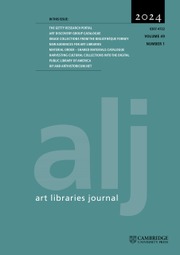No CrossRef data available.
Article contents
Archiving as knowledge production: Research practices at Salt
Published online by Cambridge University Press: 20 January 2025
Abstract
This article provides a comprehensive review of Salt's approach to knowledge generation in art history, focusing on its role as a cultural institution in Turkey. The text explores the function of research institutions and the evolving role of archivists in preserving and disseminating knowledge to a broader user base. The paper examines the concept of the archive within the framework of transparency and contingency, specifically by reviewing chosen research and archival projects conducted by the institution. It elucidates diverse research methodologies employed in the analysis, representation, and availability of archival materials in these endeavors, underscoring the significance of user engagement in expanding knowledge.
- Type
- Research Article
- Information
- Copyright
- Copyright © The Author(s), 2025. Published by Cambridge University Press on behalf of ARLIS
References
1. Elkins, James, Stories of Art (New York: Routledge, 2002), 89.Google Scholar
2. Elkins, Stories of Art, 117.
3. Wilson-Goldie, Kaelen, “Lost and found: On artists, artworks and archives,” in Speak, Memory: on archives and other strategies of (re)activation of cultural memory, ed. Carderera, Laura (Cairo, 2010), 13Google Scholar.
4. Salt is a not-for-profit cultural institution in public service, engaging in research, exhibitions, publications, web projects, conferences, and other public programs in Turkey. Salt's programs are distributed at Salt Galata and Salt Beyoğlu buildings in Istanbul. The institution works in the intersections of different disciplines such as visual practices, the built environment, social life, and economic history. See the institution's website: https://saltonline.org/en/home
5. Salt Research comprises a specialized library and an archive of physical and digital sources and documents on art, architecture and design, social life, and economic history. Focusing primarily on Turkey and its surrounding region, the archival collections at the institution encompass over 2,000,000 unique digitized resources. As part of a long-term commitment to digitizing resources at Salt Research, the institution makes documents and sources universally available via saltresearch.org. They are used under the terms and conditions of the Creative Commons Attribution-NonCommercial-NoDerivatives 4.0 International (CC BY-NC-ND 4.0) license.
6. İz Öztat and Sezin Romi, “Archives in The Making, for The Making” in Stories and Threads: Perspectives on Art Archives, eds. Sara Buraya Bond, Jennifer Fitzgibbon, Sezin Romi (L'Internationale Online, 2022), 37, https://internationaleonline.org/publications/stories-and-threads-perspectives-on-art-archives/.
7. Buchanan, Alexandrina, “‘Material evidences surviving in the form of writing’: Materiality in archival theory and practice,” in The Materiality of the Archive, eds. Breakell, Sue and Russell, Wendy (London: Routledge, 2023), 19Google Scholar.
8. Öztat and Romi, “Archives in The Making, for The Making,” 37.
9. López, Miguel A., “South-South intersections: Southern Conceptualisms Network and the political possibilities of local histories,” in Speak, Memory: on archives and other strategies of (re)activation of cultural memory, ed. Carderera, Laura (Cairo, 2010), 49Google Scholar.
10. Vasıf Kortun, “Questions on institutions,” January 12, 2018, Salt Blog, https://saltonline.org/en/2009/questions-on-institutions?blog.
11. Beatriz Fernández Rodríguez and Carolina Santamarina, “Institutional Archive Practices at the Museo Reina Sofía,” in Stories and Threads: Perspectives on Art Archives, eds. Sara Buraya Bond, Jennifer Fitzgibbon, Sezin Romi (L'Internationale Online, 2022), 127, https://internationaleonline.org/publications/stories-and-threads-perspectives-on-art-archives/.
12. For further information see Sezin Romi, “Time of transformation: Research, resources, and access at SALT,” Art Libraries Journal, Volume 47, Issue 2 (April 2022): 32–39, https://doi.org/10.1017/alj.2022.2.
13. Refik Anadol, Archive Dreaming, Salt Galata, April 20 – June 11, 2017,” Salt, accessed June 22, 2024, https://saltonline.org/en/1627/archive-dreaming?q=archive+dreaming.
14. Vasıf Kortun, Email to author, April 25, 2024.
15. “'Scared of Murals', Salt Beyoğlu, January 31 – April 21, 2013,” Salt, accessed June 22, 2024, https://saltonline.org/en/471/scared-of-murals?q=scared.
16. “Turkey's Participation In International Biennials, 2016,” Salt, accessed June 22, 2024, https://saltonline.org/en/1393/turkeys-participation-in-international-biennials?q=biennials.
17. Aynur Gürlemez Arı, Email to author, June 10, 2024.
18. They are available in Turkish: Aynur Gürlemez Arı, “Sabri Berkel'in 1962 Venedik Bienali Serüveni,”January 5, 2021, Salt Blog, https://saltonline.org/en/2311/sabri-berkelin-1962-venedik-bienali-seruveni?blog; Aynur Arı Gürlemez, “Ars¸iv Belgelerinde 1957 São Paulo Bienali Türkiye Sergisi,” August 5, 2021, Salt Blog, https://saltonline.org/en/2364/arsiv-belgelerinde-1957-sao-paulo-bienali-turkiye-sergisi?blog.
19. Demir, Duygu and Romi, Sezin, eds., İsmail Saray (Istanbul: Salt, 2018), 109Google Scholar.
20. See İsmail Saray, “EA-ARURU-KI,” Salt Research, İsmail Saray Archive, https://archives.saltresearch.org/handle/123456789/207934?locale=en.
21. See “Gallery for Peace,” The Museum of Modern and Contemporary Art Koroška (KGLU), accessed June 22, 2024, https://www.glu-sg.si/en/exhibition/galerija-za-mir/?from=eae.
22. Demir and Romi, İsmail Saray, 7.
23. See the e-publication It was a time of transformation (Istanbul: Salt, 2013), https://saltonline.org/media/files/it_was_a_time_of_conversation_scrd-1.pdf.


